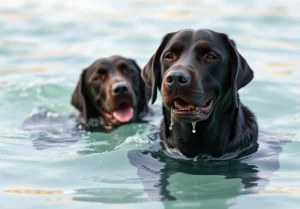Watching your furry companion sprint with the energy of a thousand suns is heartwarming until the weather gets as hot as their enthusiasm. It’s all fun and games until the heat turns against us, and by us, I mean our panting, fluffy friends who might not know when to hit the brakes on playtime under the sweltering sun.
In this blog post, you’ll learn everything you need to keep your dog safe from the harsh embrace of heatstroke. Let’s ensure your canine stays as cool as a cucumber, no matter the mercury level!

Quick Takeaways:
- Schedule walks during cooler times and always provide access to fresh, cool water to prevent heatstroke.
- Recognize early signs of overheating in dogs, such as excessive panting, drooling, and lethargy, to act swiftly.
- If heatstroke occurs, immediately move your dog to a cooler area, apply cool water, and contact a vet for guidance.
What is Heatstroke in Dogs?
Heatstroke in dogs is a critical condition that occurs when a dog’s body temperature rises beyond a safe level, typically above 103°F. It can lead to severe health issues, including organ failure and death if not promptly addressed. Signs of heatstroke in your furry friend include excessive panting, drooling, reddened gums, lethargy, uncoordinated movement, vomiting, and in severe cases, loss of consciousness. Recognizing these symptoms early can be a game-changer in preventing your pet from suffering the dire consequences of this condition.
How Can You Tell If Your Dog Is Overheating?
Beyond the obvious indicators like heavy panting and visible distress, there are subtler signs that could suggest your dog is starting to overheat. These include:
- Increased Heart Rate: Dogs typically have a resting heart rate of 60 to 160 beats per minute, depending on their size. An overheated dog will have a heart rate noticeably higher than their norm.
- Excessive Drooling: While some panting and drooling are normal, particularly for certain breeds, an increase in thick, sticky saliva can be a sign of overheating.
- Glazed Eyes: An overheated dog might display a glassy-eyed appearance, indicating distress or discomfort.
- Refusal to Move: Dogs that usually enjoy being active but suddenly seem lethargic or refuse to move might be experiencing the effects of overheating.
By paying close attention to these less pronounced signs, you can prevent a minor issue from turning into a dangerous situation.
What Can You Do to Prevent Heatstroke in Dogs?
Preventing heatstroke is all about keeping your dog cool and comfortable, especially during the hot summer months. Here are several strategies you can adopt to safeguard your pet:
-
Optimize Walk Times: Schedule walks during the cooler parts of the day, such as early morning or late evening, to avoid the peak heat.
-
Create a Cool Retreat: Ensure your dog has access to a shaded, ventilated area with plenty of fresh, cool water. A cooling mat can also provide relief.
-
Hydration is Key: Carry water for your dog on walks or any outdoor activities. Consider investing in a portable dog water bottle or collapsible bowl.
-
Never Leave Your Dog in a Car: Even with the windows down, a parked car can become a furnace on a hot day, putting your pet at serious risk of heatstroke within minutes.
-
Use Dog-Friendly Sunscreen: Dogs, especially those with short coats and light-colored noses, can get sunburned. Apply pet-safe sunscreen on their most sensitive areas.
-
Dog-Friendly Frozen Treats: Offer your dog some frozen treats to help cool them down. You can freeze chicken broth in ice cube trays or make a fruit smoothie popsicle. Here’s a unique tip: Mix a little apple cider vinegar with water, and freeze it. This not only helps to cool your dog down but also provides a healthy treat that can improve coat condition.
Remember, every dog is unique, and factors like breed, age, and overall health can affect their susceptibility to heatstroke. By applying these strategies and always staying vigilant, you can help ensure your dog enjoys a safe and fun summer.
When and How Should You Act If Your Dog Shows Signs of Heatstroke?
When your furry friend begins to show signs of heatstroke such as excessive panting, drooling, lethargy, or even vomiting, time is of the essence. Here’s a step-by-step guide to spring into action:
- Move your dog to a cooler area immediately. It can be indoors with air conditioning or a shady spot if you’re outside.
- Apply cool (not cold) water to your dog’s body. Avoid ice or very cold water, as this can worsen the situation. A damp towel can be gently laid over their body.
- Encourage your dog to drink small amounts of cool water without forcing them, to avoid the risk of choking.
- Use a fan to help lower their body temperature gradually. Direct airflow can provide immediate relief.
- Contact your vet or an emergency animal hospital right away. Even if your dog starts to feel better, heatstroke can have delayed effects. It’s crucial to have them checked to ensure there are no underlying health concerns.
Remember, every moment counts, so don’t hesitate to act quickly and efficiently.
How to Keep Your Home Cool for Your Dog
Ensuring your dog remains comfortable during the hottest months doesn’t have to be a challenge. Here are some tips for keeping your home cool and welcoming for your canine companion:
- Make use of fans and air conditioning. It’s not just about keeping the air cool but also ensuring it circulates well through your living space.
- Keep your dog out of hot zones. Areas like sunny windows can quickly become too warm for your dog. Use curtains or blinds to block out the heat.
- Provide cooling mats or wet towels for your dog to lie on. These can offer a refreshing retreat from the heat.
- Ensure fresh, cool drinking water is always available. Consider adding ice cubes to the bowl to keep the water colder longer.
- Experiment with DIY air conditioning. Place a bowl of ice in front of a fan to chill the air blowing through your home. This little trick can make a big difference in bringing down room temperatures.
One unique tip that often goes overlooked involves adjusting your dog’s diet during extreme heat. Feeding your dog during the cooler parts of the day and opting for lighter meals can prevent them from feeling overheated after eating. It’s a simple yet effective strategy to keep their body temperature in check.
What Are the Long-Term Effects of Heatstroke on Dogs?
The aftermath of a heatstroke can extend far beyond the immediate distress. Here’s what dog owners need to know about the potential long-term impacts:
- Organ damage: Heatstroke can lead to serious issues like kidney failure, liver damage, and gastrointestinal problems. Organs can suffer from the extreme temperatures, leading to long-term health concerns.
- Brain swelling: Elevated body temperatures can cause swelling in the brain, which might result in seizures or long-term neurological impairments.
- Respiratory distress: Heatstroke can damage the airways and lungs, leading to breathing difficulties that could become chronic.
- Blood clotting disorders: In some cases, heatstroke can disrupt normal blood clotting, leading to issues like disseminated intravascular coagulation.
Prevention is, without a doubt, the best approach to protecting your dog from these severe outcomes. Keep a vigilant eye on the weather, never leave your dog in a parked car, and ensure they have a cool, comfortable space at home. Remember, taking immediate action at the first sign of heatstroke can significantly reduce the risk of long-term damage to your beloved pet.
By understanding the urgency and having the know-how to act swiftly, as well as taking preventive measures to ensure a cool environment, you’re not just being a good pet owner—you’re being your dog’s hero. Keep this guide handy, and you’ll be well-equipped to ensure your dog remains happy, healthy, and cool, no matter how high the mercury rises.
Alex, a passionate animal lover, has experience in training and understanding animal behavior. As a proud pet parent to two dogs and three cats, he founded AnimalReport.net to share insights from animal experts and expand his knowledge of the animal kingdom.




